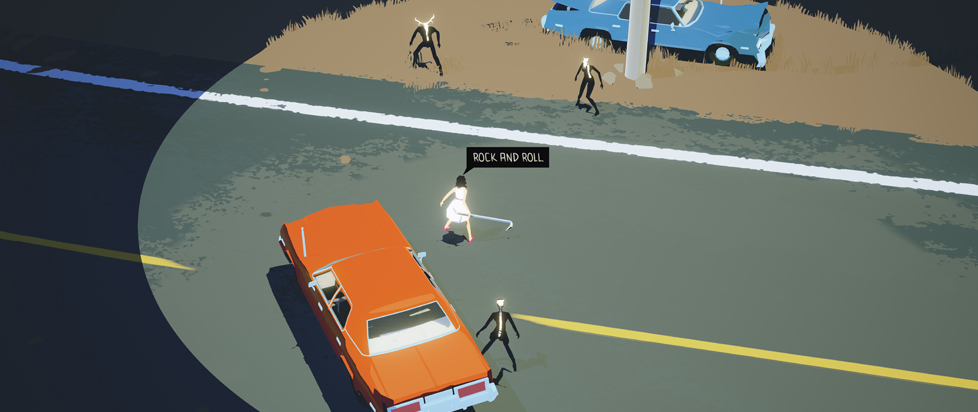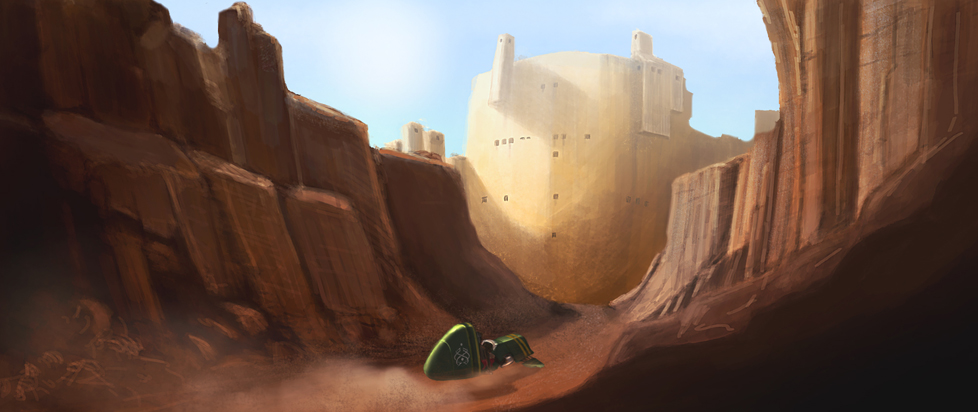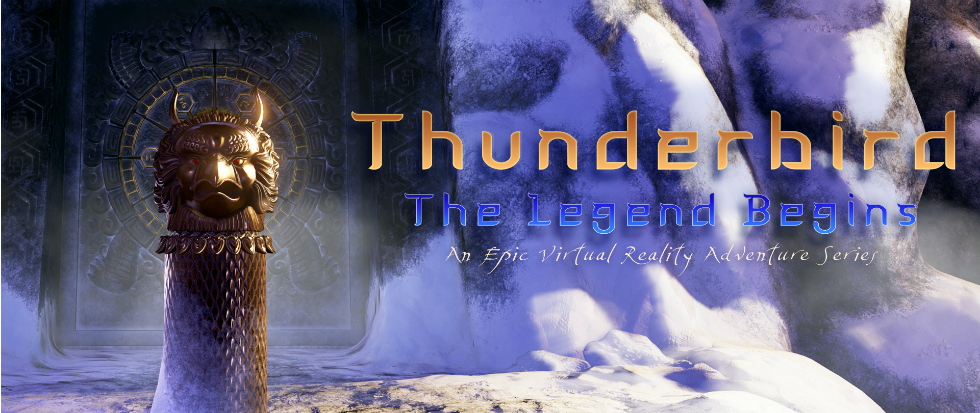
Revving the Engine: Thunderbird
This series of articles is made possible through the generous sponsorship of Epic’s Unreal Engine. While Epic puts us in touch with our subjects, they have no input or approval in the final story.
———
VR can literally transport a person to another realm, so it should be no surprise that Innervision Games is developing a game intended to mimic a transcendental experience.
The father and son team of Tony and Kai Davidson seek to do this with Thunderbird by using the conventions of the puzzle-based adventure game to mimic the introspective challenges of a transcendental experience. Kai, whose dream of exploring an emerald cavern high up the face of a massive mountain inspired the game, is serving as the art director while Tony, who previously worked on Riven (and whose early job as a chimney sweep conjures for me the bedraggled protagonist of some unknown Paolo Coelho novel), is handling the technical side.
Thunderbird is scheduled for release to in-home audiences in summer of 2017, with possible smaller chapters hitting location-based VR venues sooner. Despite the looming deadlines, Tony was kind enough to take time out of his schedule to discuss VR development and ecstatic visions.
Can you describe Thunderbird and its story?
Tony Davidson: The setting for the beginning of Thunderbird takes place on a high mountain ledge that is inspired by Mt. Kailash in the Himalayas and the ending of the experience, which takes place inside a very large caldera, is inspired by Crater Lake, Oregon. The journey in between takes place inside the mountain itself and consists of areas like a large emerald cavern inspired by my son Kai’s dream, which spawned the whole concept behind the Thunderbird experience.
We wanted to begin the journey at the highest point on earth, where nothing higher could be reached or attained, so the player must turn their search inward in order to reach the heart of the experience. Once inside, the core experience begins to unfold, which we refer to internally as the “initiation sequence” since we fashioned it after the second phase of the Bardo experience, which is the part of the journey where we pass the player through a series of bright colored lights as described in the Bardo Thodal (better known as “The Tibetan Book of the Dead”).
Before entering the central caldera region that lies at the heart of the quest, the player passes through a sequence inspired by Pluto’s Gate, now residing in modern-day Turkey. However, in our experience the player encounters a multitude of pod-like creatures that feed off the toxic gas from the surface of the volcanic lake, which is released into the atmosphere as they float up into the air like tiny hot-air balloons. As with Pluto’s Gate, this gas induces hallucinations that serve as the catalyst for the vision that occurs at the climax of the journey.
The idea is that this whole visionary experience that has been naturally accessible for ages has since been carefully shrouded behind a series of technological barriers which represent the sort of mental obstacles that must be surmounted before reaching this visionary state that we’re helping concoct for the participant.
These barriers or mental challenges manifest themselves within the experience in the form of interactive puzzles. Each of these puzzles are designed to carry the player through the journey at a specific pace, which not only enables the story to unfold directly in front of them, but also helps to prepare them mentally by continually reinforcing a deeper state of presence until it becomes so powerful that one can perceive the unbelievable as believable. That’s the goal for us, to create an experience where myths come true and legends become real, right before your eyes.
In the web site text, you mention Riven and Indiana Jones. I wonder if you could expand on how these two creations influenced Thunderbird? And what other things – movies, games, books, etc. – you’ve drawn inspiration from?
Tony Davidson: I mention Indiana Jones because it’s really the easiest way for me to describe the Thunderbird experience to the uninitiated. Thunderbird shares many of the core attributes of an Indiana Jones adventure, where exploration is key and puzzle-solving interactions are generally tied to hidden environmental effects that allow the experience to unfold incrementally until the central focus of the journey has been revealed. This is very similar to the formula that we are using for Thunderbird.
We tend to describe Thunderbird as being a virtual vision-quest that uses mentally challenging obstacles in the form of puzzles to prepare the player for a profound experience based on an ancient and universal legend or myth known in the western cultures as the Thunderbird.
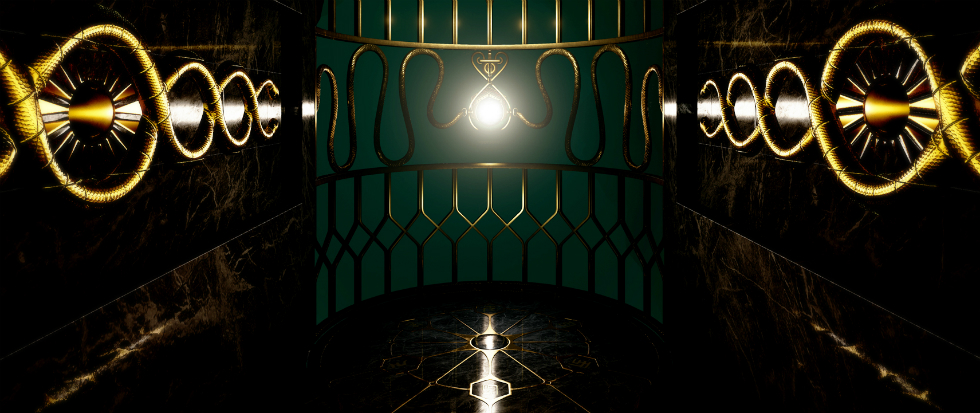
The Native Americans speak of a legend surrounding Crater Lake in Oregon where a giant battle took place millions of years ago between the great sky god and the god of the underworld and, in fact, indigenous peoples still travel many miles to this sacred site to this day to embark on a vision quest. This is the basis for the epic battle that unfolds at the heart of the experience and culminates in the triumph of the Thunderbird over the giant water serpent that represents the god of the underworld.
We’re both very inspired by the universal myths and archetypes that have somehow managed to scale the breadth of time and space to include virtually all the native and ancient cultures of our earth. From Native Americans to the Himalayas, we find a common thread among these indigenous peoples that is rather fascinating to us both and it’s these time-honored legends like the Thunderbird that we are most inspired to create in VR.
In the demo clips, I see a bit of the surrealism of Myst and Riven mixed with a strong Eastern aesthetic. Can you elaborate on what we’re seeing and, perhaps, what we aren’t?
T. D.: With Thunderbird, we wanted to blur the line between realism and surrealism in order to create a an experience that is both magical and believable. This was important for us because our primary goal is to make the unbelievable appear as believable and to do that we need a strong sense of realism in the worlds that people will inhabit. It’s very important to sell the experience to the user so that their suspension of disbelief allows them to embrace it as if it’s really happening. When that magical moment happens it’s what we VR developers refer to as “presence” which is sort of the holy grail of VR design.
So, we use the surrealism to create a magical moment or encounter but we are careful to anchor it with a strong sense of tangibility and the quality of realism that we approach in our art style. So our look for the project was sort of born out of the necessity of finding a balance between these two genres in order to produce the desired effect on the user. So in our case, developing the design style for Thunderbird was very much a “form follows function” approach.
The eastern influences are present because we set the location of the experience in the Himalayas, so the designs reflect those of the native inhabitants found in that region. The Himalayas divide two great countries of India and China, so we have influences from both sides of the mountain range. For example, the iron door borrows its design from the Chinese Tortoise while the small statue borrows from India’s “Garuda” which is their equivalent of our western Thunderbird.
Adventure games like this seem to me to be particularly challenging to design in VR. Can you share you approach and some of the challenges you’ve encountered?
T. D.: I think this is a very important point because that certainly seems to be the case in my own experience. When I first started creating VR content, I believed that these sort of first-person adventure games would translate seemlessly into VR, but the fact is they don’t, so I had to learn that the hard way. While there are some elements of traditional adventure gaming that work well in VR, many of the core design features that support those experiences are actually quite toxic for VR.
Locomotion is a huge issue with first-person experiences in VR and since these traditional adventure games rely so heavily on the open world approach, it makes it a very difficult design challenge for us. The issue of sim-sickness is very real and is a big threat to the success of commercial VR, which essentially means that the old approach of using a gamepad to navigate around the world is no longer an acceptable form of locomotion.
The best approach we’ve found is to design an experience that allows users to move around freely within a large room but the fact is that not many people have the space for it, so we’ve been working on some alternative solutions like teleportation, which is very promising. Still, locomotion in VR is something that I fear is going to haunt developers for a long time to come.
Interaction is another very big hurdle for first-person VR since the technology to support it is still being developed at this stage. This is actually the biggest issue with developing for VR that I’ve encountered over my three years of experience, which is that the technology is still being developed and is evolving quite rapidly to the point of making many prior established designs obsolete in a matter of months, or even weeks in some cases.
A VR experience is entirely dependent on the underlying mechanics that support it and these sort of features are always built on the groundwork laid below it. The problem is that the groundwork is still changing and without a foundation to work from it’s very difficult as a content developer to know where to focus your energy, so you have to be bold and willing to take big risks if you want to make a serious contribution to the medium.
VR developers who are working in the space are true pioneers, because the work we commit ourselves to is creating the future of the medium itself. Since very early on, a lot of us have been working alongside the hardware manufacturers and doing the best we can to exploit the new features as they develop. The very fact that the hardware keeps cycling so quickly makes it the biggest obstacle to designing great experiences from the ground-up and this affects all forms of content I think.
How does the game scale from full room to standing mode? Does that substantially alter the experience in either direction?
T. D.: We didn’t have to alter the experience much when we scaled down to standing mode from our original room-scale design. It was mostly just a matter of developing a comfortable and intuitive teleportation mechanic that functions within the scope of the boundaries that make up the environments of Thunderbird.
Our teleportation mechanic works a little differently than others in that we wanted to place people in specific locations so we could take full advantage of the smallest capacity of playspace and allow for a wide range of interaction within it. For interactions like looking through the periscope while rotating it around 180’ degrees, it requires quite a bit of space to pull off, so we have to make sure that the player stays confined within that area or else they may end up triggering the virtual boundaries of their playspace as they move outside of them. Little annoyances like these boundary warnings can really break immersion and kill your sense of being present within the world, so it’s important that we avoid them wherever possible.
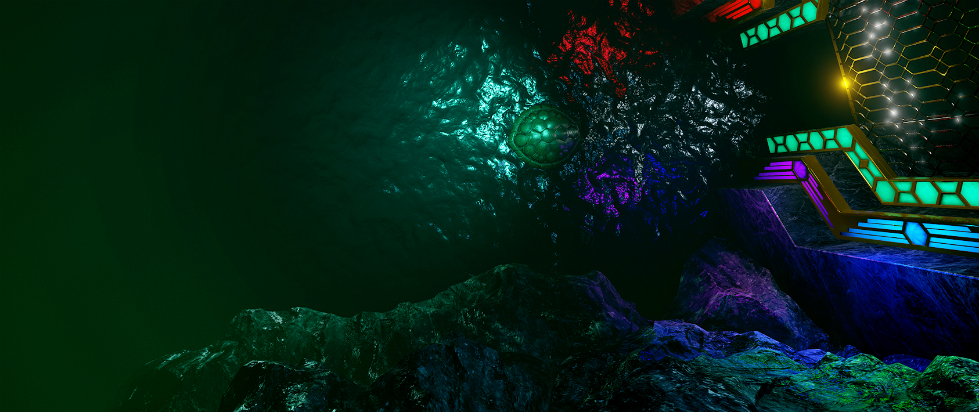
One problem I’ve found with standing mode compared to room-scale is that once people begin using it, they tend to stay locked firmly in one position rather than leaning around their space, which can make a big difference in terms of the sense of depth that you feel from being inside of that world. What we’ve found is that, while standing mode is an acceptable alternative to room-scale, it actually diminishes the sense of presence to the point of making or breaking the experience for a small percentage of users.
Generally speaking, I think the difference between true room-scale experiences and standing ones is pretty significant. With VR it’s all about the sensation of presence which is the phenomenon of feeling like you are really there inside the world that you see all around you. So as developers, we are doing whatever we can to provide people with the keys they need to make that happen. Some things are big immersion-boosters and it just so happens that walking around inside the virtual world is a huge boost for everyone.
Can you explain how the hand presence works and the thinking behind including it? The biggest challenge I’ve experienced with VR is not being able to interact with objects as naturally as you can in the real world (I recently tried to close a drawer I just opened with my elbow, for instance, and found it very jarring to be reminded in that way that I wasn’t in the real world). I suspect this is something you’ve devoted a lot of thought to while developing a rich world to explore that is full of physics based puzzles.
How do you approach this problem (if you even see it as a problem!) and how have you gone about overcoming/mitigating those sorts of dissonance?
T. D.: We wanted our hands to look and act like real hands so that the overall effect would be very acceptable for everyone. We chose to go with a more ghostly hand to eliminate any discrepancies between age, race or gender but, beside that, they look and function like real hands.
We spent a lot of time sculpting and orientating the hands so that they were positioned as close as we could possibly get them to your actual hands in real life. If you don’t get the alignment just right then it can cause uncanny feelings because people are extremely familiar with their hands and will notice any discrepancies right away. This is the type of thing you want to avoid in VR since it can break immersion or at least diminish the suspension of disbelief that you need for all the magic to work.
After fitting the hands to the controllers, we spent a great deal of time on the grab interactions by rigging and skinning the detailed hand models so that we could create custom animations for each of the virtual objects that you can interact with inside the world. This allows us to achieve a high level of realism and accuracy that matches what you would expect to experience with your real-life hands.

There were actually a lot of techniques we used to get the hands right but one of the things we did to increase the believability of the hands was break the 1:1 tracking of the controllers to help smooth out the overall motion of the hands, which creates the illusion of having weight, so that they react very much like your real hands do when you move them around in space.
If you watch people who try VR for the first time, one of the very first things people tend to do is either hold up their hands to see if they exist in the virtual world, or reach out and try to touch something around them inside the virtual space. When you try to do this and fail, it makes the experience feel empty and awkward, which is nowhere as fulfilling as having your hands present inside the world with you.
Overall I think that hand presence is an essential part of the VR experience because it gives us a stronger sense of presence within the world and helps strengthen our sense of purpose by allowing us to interact with our environment just as we do in real life.
What do you hope to accomplish with Thunderbird?
T. D.: For us, it’s all about honoring the medium and creating something meaningful. We’re very inspired by VR as a medium and are really driven by the challenge of discovering its true potential. We want to create something that showcases the potential of VR but we also want to do something with a lot of depth.
We vibe to the ancient legends and myths because we both feel strongly that they deserve to have a place in this new medium. We think there is a lot of magic and great inspiration to be found in these time-honored stories of our ancestors and we’d like to be some of the ones that make these sort of experiences accessible to others in VR.
So with Thunderbird, I’d say that we’re essentially creating a series of magical moments to carry people through a memorable journey that we hope will inspire and remain with them for the rest of their lives.
Are there any advantages or disadvantages to using Unreal to develop Thunderbird?
T. D.: Developing in Unreal has been a god-send for us in many ways. The original reason for choosing to use Unreal for Thunderbird was that we wanted to have hand-presence and needed an engine that could support fully-tracked motion controllers. At the time, Epic were the only ones to support motion controllers and Unreal has been great about offering early support for VR features which is what developers really need at this stage of the game to succeed. There is no doubt that they are taking VR very seriously and I can really appreciate that.
One of the things that makes Unreal great is the visual programming system it has. On day one of working with Unreal, I discovered the amazing power of BluePrints, which is this very user-friendly node-based graphical interface that allows you to program without knowing how to code. My background is primarily with art and design, so I tend to be much more visually oriented. With their BluePrint system, I’ve been able to do things that I would never have been able to do given my very limited coding skills. It’s fantastic for quickly prototyping ideas and it’s just really boosted our capabilities on Thunderbird.
How has the Unreal Dev Grant affected your work? Did the grant allow you to do things with Thunderbird that you wouldn’t otherwise have been able to?
T. D.: The grant from Epic was a huge boost for us at a time when we really needed it. We’re 100% self-funded and were about nine months deep into the project when we received the Unreal grant and so the timing was really perfect for us. We were finally able to buy essential hardware that we desperately needed and were able to focus on Thunderbird full-time for many months (and counting), which was one of the best things we could have asked for.
I have to admit that it’s a very rewarding feeling to have someone like Epic be so supportive of our efforts. It’s both validating and empowering at the same time and we really can’t thank them enough for everything they are doing for us and VR in general. We’re grateful to have their support.


